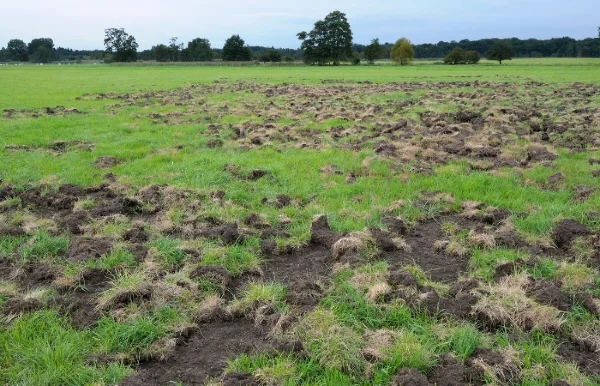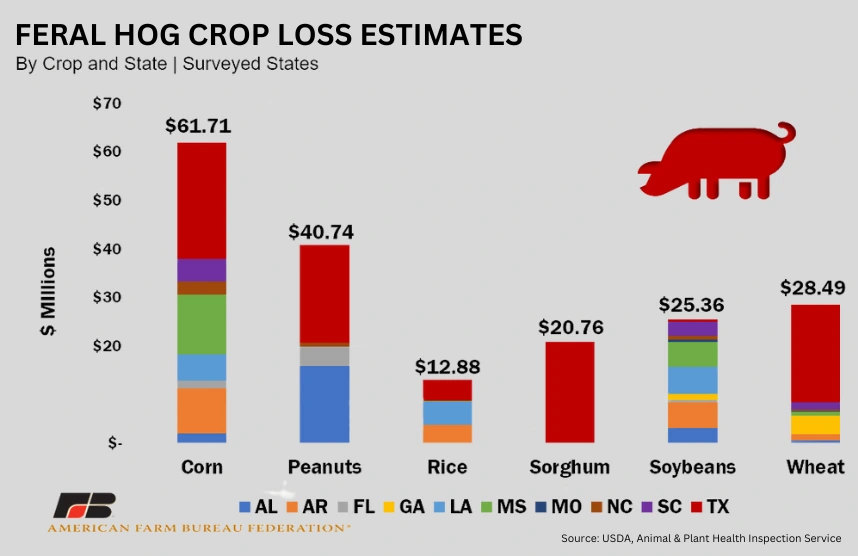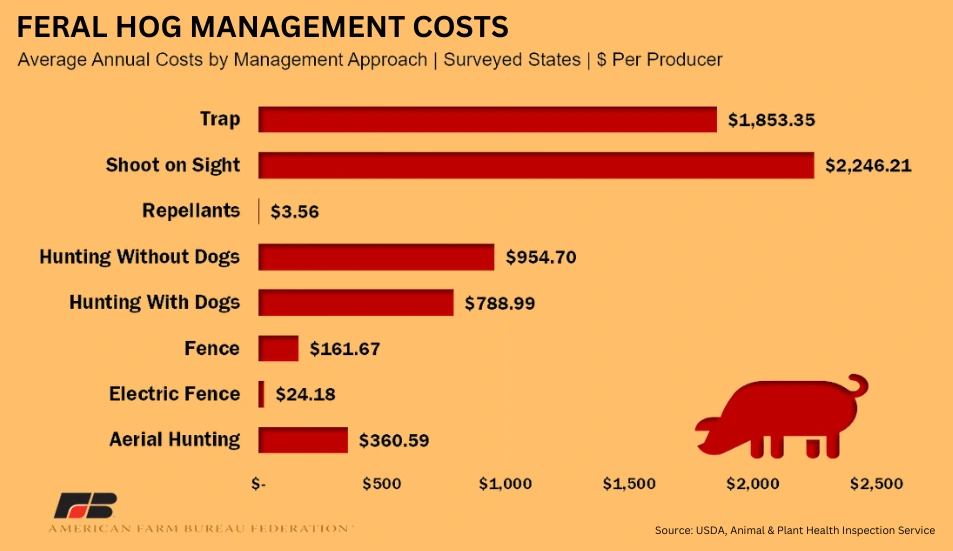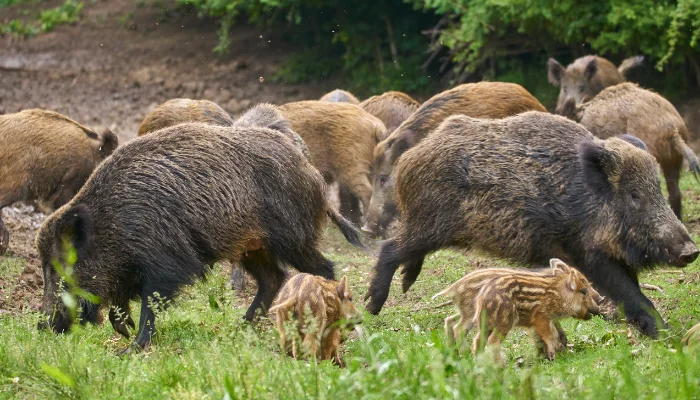In the vast American landscape, a peculiar and pressing issue confronts farmers, ranchers, and wildlife enthusiasts alike – the burgeoning population of invasive wild boars. These creatures, while a part of the continent’s diverse fauna, have become a symbol of the complex challenges posed by invasive species. In this article, we explore why the problem of wild boars in America is more than just a question of wildlife management, but a nuanced dilemma involving ecology, public safety, and agriculture.
Wild boars in America aren’t just another wildlife species; they’re an invasive force. Originating from European wild pigs brought to the continent in the early 20th century, these animals have thrived, with their population skyrocketing, particularly in states like Texas. This explosive growth is attributed to their remarkable adaptability and prolific breeding capabilities.
But let’s be clear, wild boars aren’t a unique species separate from the pigs you find on pork farms. They’re the same – just feral. Europeans brought pigs to this continent as a food source, some escaped and that’s where we are today!

America's $2.5 Billion Wild Hog Problem
The wild hog crisis in the United States is more alarming than ever. With an estimated population exceeding 9 million, these invasive animals have expanded their territory across more than three-quarters of the country, including states like California, Hawaii, and Michigan, which now report significant feral hog populations.
- Financial Toll: The U.S. Department of Agriculture estimates that feral hogs cause approximately $2.5 billion in agricultural damages each year, a staggering figure that underscores the scale of the problem.
- Population Growth: Since their introduction in the 1500s, the feral swine population has exploded, particularly in states like Texas, which alone reports over 2.4 million sightings.

The Environmental Catastrophe of Feral Swine
The invasion of feral swine in the United States isn’t just an agricultural concern; it’s an ecological disaster. According to the Animal and Plant Health Inspection Service (APHIS), these invasive pigs are accelerating the decline of nearly 300 native plant and animal species, many already teetering on the brink of extinction.
Feral hogs’ omnivorous diet leads them to consume everything from the nests of threatened sea turtles to vital native milkweed for monarch butterflies. As Tyler Campbell, a biologist and feral swine expert at the East Foundation, puts it, “If something has a carbon molecule, they can eat it.”
Threat to Endangered Species
Their foraging habits destroy ground nests of game birds like the bobwhite quail, pollute the breeding ponds of endangered species like the Houston toad, and deplete forest resources critical for bears, squirrels, wild turkeys, and deer.
Kurt VerCauteren, the feral swine and ungulate project leader at the APHIS National Wildlife Research Center, warns of the expanding reach of these swine. Without effective control measures, “they’ll end up in all but the very driest and coldest counties in the U.S.”
Feral hogs are a bonafide public health threat. They carry over 40 parasites and 30 bacterial and viral illnesses, posing risks to humans, livestock, and other animals with diseases like brucellosis and tuberculosis.

The Challenge of Control
Controlling this population has been an ongoing battle. Methods range from aerial hunting using helicopters to ground-level trapping and hunting with dogs. Despite culling 60-80% of the population annually, their numbers rebound, partly due to the lack of natural predators and their incredible reproductive rate.
States like Florida, Georgia, and Texas are at the forefront of this crisis. The Missouri Feral Hog Elimination Partnership, for example, has removed over 54,000 feral hogs since 2016, and the problem continues.
J.P. Fairhead, feral hog program coordinator for the Arkansas Game and Fish Commission, aptly sums up the situation: “It’s a never-ending battle. If even one sow and one boar escape, you could be right back where you started within a year.”
Why Don’t We Just Eat Them?
One might wonder, why not utilize this abundant resource for food, particularly since we’ve very openly suggested controlling other invasive species? The answer lies in the wild boars’ omnivorous diet, which includes garbage and some very potentially harmful substances. Consuming their meat poses a risk of transmitting up to 24 different types of diseases.
While this health concern doesn’t make consuming the meat impossible, it certainly does complicate the process by adding a level of risk that invasive carp, for example, doesn’t carry. This doesn’t mean that it can’t be done!
The Wolf Factor
Adding another layer to this ecological puzzle is the presence of wild wolves, another predator with its challenges. While wolves do prey on wild boars, they also pose threats to livestock and have been known to attack humans. This dual threat complicates the management strategies for both species.
No Easy Solution
The situation begs the question: What can be done to effectively manage these invasive species while preserving the balance of America’s diverse ecosystems? The answer isn’t straightforward. It requires a multi-faceted approach involving wildlife management, ecological preservation, public safety considerations, and possibly, innovations in how we perceive and utilize these animals.
Public hunting and professional trapping remain key strategies in managing feral hog populations. But as David Yeates, CEO of the Texas Wildlife Association, points out, controlling these animals is a Sisyphean task: “You have to knock down 70 percent of a population a year just to maintain the status quo.”
With more than 2 million feral hogs, Texas has by far the largest population in the country.


Community-Led Efforts and Innovative Strategies Against Wild Boars With Mixed Results
The battle against invasive wild boars has spurred a variety of community-led initiatives and creative strategies, some successful, others less so, but all aiming to tackle this growing ecological and agricultural problem.
The "Hog Apocalypse" in Texas
In Texas, where the wild boar population is particularly problematic, the state Agriculture Commissioner famously launched a plan dubbed the “Hog Apocalypse.” This initiative involved using a controversial, powerful poison known as warfarin, commonly used as a rat poison and a blood thinner in humans.
The plan, however, faced significant backlash from hunters, environmentalists, and meat processors, leading to its eventual abandonment due to concerns over ecological impact and food safety. And, in truth, knowing what’s now known, the great Texan hog apocalypse most likely wouldn’t have worked long-term. Feral pigs replenish their population numbers very fast, which is, of course, one of the biggest problems. Their fast and plentiful reproduction is, after all, the main reason pigs became so popular as a meat source.
Smart Trapping Systems
Some communities have turned to technology for a solution. In Alabama, for instance, a group of farmers and researchers developed a “smart” trapping system. Using cellular technology, these traps allow for remote monitoring and control, increasing efficiency and reducing the labor-intensive process of trapping. These high-tech traps can be activated to close when a sounder (group) of hogs enters, thereby improving capture rates.
The "Eat Them to Beat Them" Campaign
In areas where wild boar meat is deemed safe for consumption through rigorous testing, communities have encouraged hunting and eating wild boars as a control method. The “Eat Them to Beat Them” campaign, for example, promotes the culinary use of wild boar meat, seeing it as both a sustainable food source and a control method.
Local restaurants and chefs have joined the cause, creating dishes that highlight wild boar meat, turning a problem into a gastronomic opportunity. Unfortunately, feral pig meat isn’t often safe for consumption and must instead be destroyed.
Community Hunting Initiatives
Several states have organized community hunting initiatives, often involving hunting competitions with prizes for the most hogs captured or killed. These initiatives not only help control the population but also foster community engagement and awareness about the issue.
The Judas Pig Technique
Borrowing a page from the “Judas goat” strategy used in the Galápagos, some areas have experimented with the “Judas pig” technique. This involves releasing a sterilized, radio-collared wild boar back into the wild.
The Judas pig then leads wildlife managers to other wild boars, helping them target and remove these invasive animals more effectively.
Fencing and Natural Barriers
In certain regions, communities have invested in extensive fencing or the creation of natural barriers to protect specific areas, such as crops or sensitive ecological zones. While labor-intensive and costly, these physical barriers can be effective in preventing wild boar encroachment.
Failed and Controversial Approaches
Not all ideas have been hits. Some communities have tried unusual methods like introducing natural predators or using drones for surveillance, but these have raised their own sets of ecological, ethical, and practical concerns.
Each of these efforts reflects the diverse and creative ways communities are tackling the wild boar problem. While there’s no one-size-fits-all solution, the combination of technology, culinary initiatives, traditional hunting, and community involvement offers a ray of hope in managing this invasive species. These community-level initiatives, from high-tech to culinary, demonstrate the innovative spirit and resilience in the face of ecological challenges.
More To Discover
- Palm Oil-Based Organic Solution Can Protect Cattle from Pests Without Insecticides
- Trailblazing Canadian Waste-to-Ethanol Plant Shuts Down 11 Years Early, Sparking New Environmental Quests
- Key Challenges at COP28: From Carbon Market Integrity to Methane Emissions and even Innovative Financing
- Seoul Government Uncovers High Levels of Toxic Chemicals in Shein Products
What’s our biggest take-away when it comes to the wild boar problem? There isn’t one single solution. Each region will have to craft and act as is most appropriate for their specific wild pig population. Some regions have boars that can be safely eaten. Others have boars that have learned to identify specific human-made traps. After all, as we all know, pigs aren’t stupid!
The wild boar dilemma in America is a vivid reminder of the delicate balance between human activities and wildlife. It highlights the need for continued research, public awareness, and collaborative efforts to find sustainable solutions.
Whether it’s through improved management practices, scientific research, or community involvement, the path forward requires a collective effort to ensure the health of our ecosystems and the safety of our communities.



















